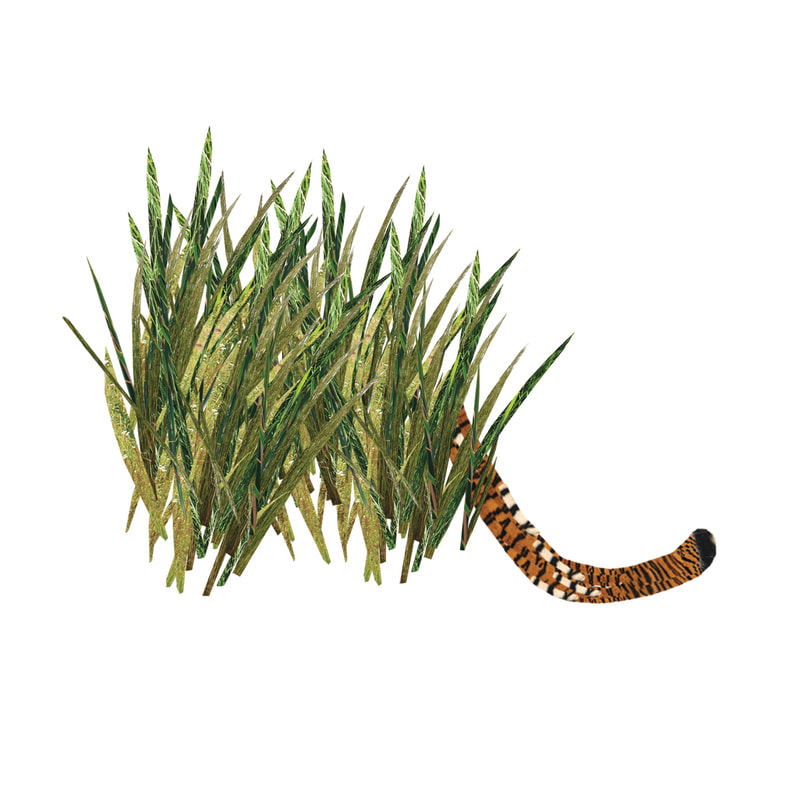Who fell the mango tree?
|
Tiger
(Panthera tigris) The tiger is the biggest member of the felidae family. Its large size and dense, black striped, orange fur make the tiger an impressive sight. The striped pattern of each tiger is as unique as our individual fingerprints. Tigers live in many kinds of forests. Their main prey are deer and wild boars, but they also hunt birds, fish and reptiles. Tigers are divided into subspecies based on their phenotypic and genetic differences. Living in different habitats, tigers have adapted to their local climate. For example, the large Amur tiger has adapted to cold winters, and has a thick, light-coloured fur. The Sumatran tiger lives in tropical forests and is much smaller in size than the Amur tiger and has shorter fur. Three subspecies have already become extinct: the Javan tiger, the Bali tiger and the Caspian tiger. Before, tigers lived in a large area in Asia and their estimated population was around 100 000 individuals. Within last 100 years, their range has decreased over 93 % and the remaining areas have shrunk into tiny, isolated spaces. Currently populations of wild tigers are found in 13 different countries in the world, for example in Bangladesh, Nepal, India, Indonesia and Russia. The tiger is an endangered animal species. The estimated number of tigers in the wild is about 5600 individuals. The number of tigers has decreased especially because of habitat loss and poaching. The bones, skin, teeth and claws among other parts of the tiger are illegally traded in the black market. Tigers are also poached in order to protect cattle or even in an act of taking revenge, if tigers have predated on cattle earlier. Recall the Who fell the mangotree fairytale again. What was the reason for the main character to poach the tiger? Because suitable habitats have been lost, tigers are more often forced to encounter areas habited by humans. We have cut down forests to build residential areas, for farming or for livestock. Remaining forested areas have shrunk and they do not provide enough food for tigers. This forces the tigers to move to feed in other areas and they might then come across and hunt grazing animals. Fortunately, all of the states, where wild tigers currently live, have decided to protect the tigers. In 2010, tiger states gathered for an international tiger conference in St. Petersburg, Russia, where the global tiger protection project was initiated. The goal of the project was to double the number of tigers living in the wild by the year 2022. During the project, habitats suitable for tigers have been restored and stricter measures against poaching have been introduced. Experience gained in the project and its results will guide the decision-making concerning tigers and their protection in the coming years. Estimated numbers of tigers in wild:
– – – – – – – – – – |
|
Additional exercise
Cultural representations of different animals and organisms shape our understanding of them, and therby our willingness to protect them and biodiversity around us. As a charismatic animal, the tiger appears in many popular culture artefacts, fairy tales and mythologies. Can you remember, where you recently saw a tiger? Think about different stories, nature documentaries, films, illustrations or other encounters with tigers in our (popular) culture. What kinds of roles does the tiger take in its various representations and how is its character represented? For example, 2022 is the year of the tiger in the Chinese calendar, and it is associated with qualities of leadership and strength. In the novel and film Life of Pi, 16-year-old Pi Patel is shipwrecked and accompanied on his life raft by a tiger called Richard Parker. Popular children’s books by the German author Janosch feature a little tiger with its friend a little bear. What kind of a character does the tiger have in The Jungle Book, or what about Winnie the Pooh cartoons? Tiger watching challenge: In how many different places can you spot the tiger during one week? Make a note, take a photo or sketch the occasion, when you encounter a tiger over the next seven days. It might be a picture on a shirt, on a bag of sweets, on television, a mention on the radio or in a story book - where else? Invite your class, your friends or your family to take part. What kind of tigers did you encounter? You can collect a tiger-spotting map together and mark the spots where you encountered the furry mammal, and shortly describe the situation. What do you think of the tigers, based on the encounters? Tip: Try the same spotting another organism or animal. Is the way the animal is represented perhaps surprising to you? Which animals do we rarely see in our culture and which ones do we come across often? – – – – – – – – – – References: * Goodrich, J., Lynam, A., Miquelle, D., Wibisono, H., Kawanishi, K., Pattanavibool, A., Htun, S., Tempa, T., Karki, J., Jhala, Y. & Karanth, U. 2015. Panthera tigris. The IUCN Red List of Threatened Species 2015: e.T15955A50659951. https://dx.doi.org/10.2305/IUCN.UK.2015-2.RLTS.T15955A50659951.en * GTRP 2011. Global Tiger Recovery Program 2010–2022. The World Bank, Washington DC. * IUCN 2021. IUCN’s Tiger Programme finds there has been an average increase of the tiger population within project sites by 40% between 2015 and 2021. https://www.iucn.org/news/species/202107/new-report-iucns-tiger-programme-finds-there-has-been-average-increase-tiger-population-within-project-sites-40-between-2015-and-2021 * Liu Y.-C., Sun X., Driscoll C., Miquelle D.G., Xu X., Martelli P., Uphyrkina O., Smith J.L.D., O´Brien S.J. & Luo S.-J. 2018. Genome-Wide Evolutionary Analysis of Natural History and Adaptation in the World's Tigers. Current Biology 28: 3840-3849. https://doi.org/10.1016/j.cub.2018.09.019 * Pirie T. 2018. Tigers confirmed as six subspecies, and that is a big deal for conservation. https://theconversation.com/tigers-confirmed-as-six-subspecies-and-that-is-a-big-deal-for-conservation-105592 * WWF: Tiikeri - Panthera tigris. https://wwf.fi/elainlajit/tiikeri/ WWF: Tiger. https://www.worldwildlife.org/species/tiger
|


